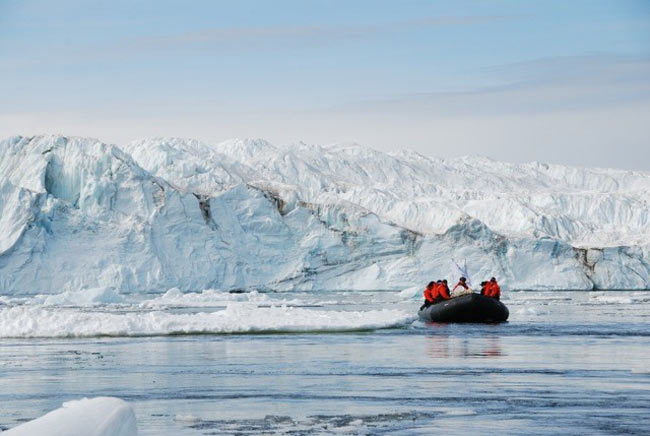 Monday 2 March 2015 11:38am
Monday 2 March 2015 11:38am
Campbell Glacier reaches the coast at Gerlache Inlet, Terra Nova Bay, Ross Sea, Antarctica
Two new research projects led, and another co-led, by University of Otago scientists are set to improve the understanding of how Antarctica's ice cover will change as the world warms.
The three studies are among six newly announced projects that will explore how ice floating at the edge of Antarctica interacts with the surrounding Southern Ocean.
The New Zealand Antarctic Research Institute (NZARI) has provided $500,000 in funding for the six studies thanks to support received from the Aotearoa Foundation and Air New Zealand.
Otago's Dr Catherine Beltran (Chemistry and Geology) will lead a project titled “Investigating Antarctic ice sheet response to past anomalous Southern Ocean warming” and Drs Christian Ohneiser (Geology) and Christina Riesselman (Marine Science and Geology) are co-leading research titled “Reconstructing the history of the Ross Ice Shelf since the Last Glacial Maximum”. The two projects will each receive $95,000 in funding.
Associate Professor Pat Langhorne (Physics) will also co-lead a project with NIWA's Associate Professor Craig Stevens. Their project is titled “Supercooled ice shelf cavity water and the influence on sea ice growth” and they will receive logistical support from Antarctica New Zealand to carry out the research.
Announcing the funding of the six projects, NZARI Director Professor Gary Wilson said, “an area which was once deemed one of the most stable parts of our planet is now showing real signs of change.”
“I congratulate these funding recipients for the ambitious nature of their science objectives. Each proposal directly supports NZARI's goal of enabling high-quality, collaborative research which seeks to answer some of the global challenges presented by a changing climate, today.”
Preliminary results from the projects are expected towards the end of 2017.
About the three projects:
Investigating Antarctic ice sheet response to past anomalous Southern Ocean warming
Dr Catherine Beltran (Departments of Chemistry and Geology)
Headline: “West Antarctic Glacier Loss Appears Unstoppable” (NASA News June 2014). Recent studies show that this melting, driven by ocean warming, has reached the point of no return. Because Antarctica can significantly increase global sea level, this faster-than-expected phenomenon is a real concern for the future. Our proposed work is to improve the understanding of the ice-ocean interactions during the last super-glacial (1 million years ago) when Antarctica partially melted due to ocean warming. Using organic geochemical proxies, we will identify the temperature threshold for melting ice-shelves and the magnitude of the phenomenon, aiming to provide crucial data to simulate future scenarios.
Reconstructing the history of the Ross Ice Shelf since the Last Glacial Maximum
Dr Christian Ohneiser (Department of Geology) and Dr Christina Riesselman (Departments of Marine Science and Geology)
Rising ocean temperatures may soon destabilise the West Antarctic Ice Sheet, which will result in sea-level rise and changes in oceanic and atmospheric circulation that will have a profound impact on New Zealand. The Ross Ice Shelf protects the West Antarctic Ice Sheet from the warming ocean. Because little is known about past Ross Ice Shelf behaviour, predictions of its future stability are challenging. We will reconstruct the Ross Ice Shelf history since the last ice age using seafloor sediment cores from the Ross Sea. Our reconstruction will test computer models of past change in order to improve forecast models.
Supercooled ice shelf cavity water and the influence on sea ice growth
Associate Professor Craig Stevens, NIWA and Associate Professor Pat Langhorne, Department of Physics
The seasonal growth and decay in sea ice coverage is arguably the largest natural annual geophysical change on the planet, with the shrinking Arctic ice being one of the clearest manifestations of climate change. But why is this shrinking Arctic ice not paralleled in the Antarctic? We are researching the possibility that the answer lies in the production of supercooled seawater beneath the giant Antarctic ice shelves that make up 40% of Antarctica's coastline. This water is very cold but also slightly fresh. As it leaves the cavity and enters the polar ocean, it spreads out as a cold surface layer promoting sea ice growth far beyond the Antarctic coast. We will combine new approaches to turbulence and ice crystal measurement to aid in better computer predictions. The field campaign will also include an art-science-education thread to better engage young minds with aspects of Antarctic science less often encountered in the media.
A list of Otago experts available for media comment is available elsewhere on this website.
Electronic addresses (including email accounts, instant messaging services, or telephone accounts) published on this page are for the sole purpose of contact with the individuals concerned, in their capacity as officers, employees or students of the University of Otago, or their respective organisation. Publication of any such electronic address is not to be taken as consent to receive unsolicited commercial electronic messages by the address holder.